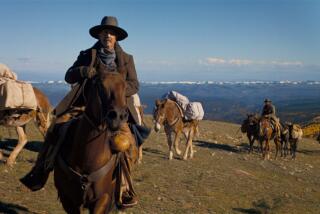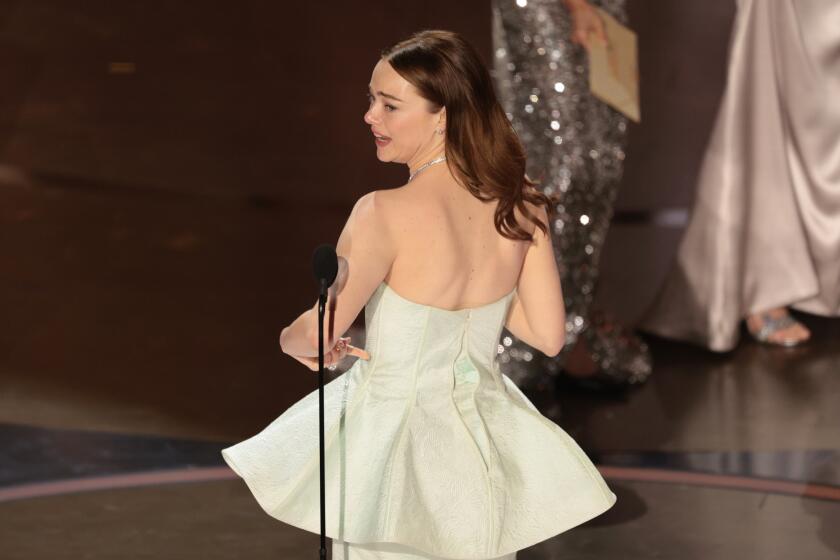TEAM SPIRIT
Scott Z. Burns was nervous. He had sent Steven Soderbergh an e-mail and gotten back a surprising reply: “Please don’t ever contact me again. If you do, you can expect to hear from my lawyer.”
It shouldn’t have been like that: Maybe Burns and Soderbergh weren’t old buddies, but they had collaborated on two pictures -- in 2004, Burns was one of several writers on “Ocean’s Twelve,” which Soderbergh directed, and Burns wrote the screenplay for the 2006 HBO feature “The Half Life of Timofey Berezin” (a.k.a. “PU-239”), on which Soderbergh was an executive producer. And now they were working on “The Informant!,” which was written by Burns and being directed by Soderbergh.
“I wondered, am I off the project?” Burns recalls. “But [producer] Jennifer Fox told me, ‘You have to give it back to him.’ And it took a while to realize that’s how he plays, that’s how he wants you to play with him. It’s an invitation.”
Burns and Soderbergh do have an understanding, which is why they’re now on their third collaboration.
Such pairings are not unfamiliar around Hollywood, particularly in Oscar season: Directors, producers, screenwriters and actors gravitate to others in their field with whom they’ve had the most successful joining of creative minds.
Often, it’s a marriage of actor and director -- of muse and Pygmalion, if you will. Pedro Almodovar has made four films with Penelope Cruz, including his most recent for Sony Pictures Classics, “Broken Embraces.” A fan of Cruz’s work, Almodovar approached her after seeing her in 1992’s “Jamon, Jamon,” and they had a meeting of the minds.
“With actors such as Penelope, you have this silent understanding,” says Almodovar, noting that many actors need to trust that their directors won’t make them look ridiculous -- even if they’re asking them to do off-the-wall things. “From the beginning, she had this blind faith in me, and that kind of faith makes the work between us very good.”
For a scene in “Broken Embraces” in which Cruz’s character returns from a post-coital trip to the bathroom and finds her much older lover either dead or sleeping, Almodovar explained the actress’ interior dialogue aloud as the cameras rolled, and she had to improvise her reactions. “You can only achieve that with actors when there is a deep understanding,” Almodovar says. “It makes things simple when someone can just catch you like that.”
“There’s a feeling-out process, a creative negotiation over the first week or so on a new set,” says Jason Bateman, whose “Up in the Air” is his second collaboration with director Jason Reitman (after 2007’s “Juno”). “You’re trying to figure out different ways to articulate your points, and they can be annoying and precious emotional points that get into a lot of actor-speak and director-speak. It’s not a beautiful process, but the results, hopefully, are better looking.”
Collaborative teams seem to work out a shorthand -- unspoken comments, implied understandings that speed the process along -- that makes actors feel safe and writers comfortable that their ideas are getting processed as intended.
“We’ll do a take and [George Clooney] will give me a look and, with a nod of my head, we’ll do another take,” says Grant Heslov, who has worked in various roles with the actor over four films and two TV series; they also share the production company Smoke House and recently released “The Men Who Stare at Goats” (Heslov directed, Clooney starred, both produced).
“It’s almost nonverbal, it’s so weird,” Heslov adds. “We’ll have a conversation about a script and write down our notes, but there’s always a lot of overlap because we’re on the same page.”
Clooney and Heslov were friends before becoming business partners; having that outside relationship with a collaborator keeps the relationship vibrant and current, which also aids the production process. Nora Ephron has known Meryl Streep on and off camera for nearly 30 years, writing 1983’s “Silkwood” and 1986’s “Heartburn,” both starring Streep. This year’s “Julie & Julia” was the first time Ephron had directed the two-time Oscar winner.
“It’s convenient when you know each other,” Ephron says. “The actor wants to know if she’s in safe hands, and the director wants to know if this is the kind of actor that you can get one good take from, or the kind of actor where you’re going to be in agony because seven or eight takes are fantastic. Is this an actor who loves notes or an actor who doesn’t need notes? Is it an actor who can improvise or would rather stick with the script? Fortunately, Meryl is all of those creatures.”
Cliques form around key crew members too, for some filmmakers; Ephron has had the same second assistant director on seven films, and Heslov says he and Clooney work with the same assistant director, production designer, cinematographer, soundman, editor and line producer on just about every film, based on scheduling. “It’s like having a family,” he says.
But it’s not always possible to take your family everywhere. Heslov and Clooney were recently in Italy, filming 2010’s “The American,” and, Heslov says, “We really don’t know anybody here. It’s a little weird not to know anybody on the crew.”
Still, there are consolations. “It’s Italy,” he says. “So how bad can it be?”
At least they have each other.
--
More to Read
Only good movies
Get the Indie Focus newsletter, Mark Olsen's weekly guide to the world of cinema.
You may occasionally receive promotional content from the Los Angeles Times.






